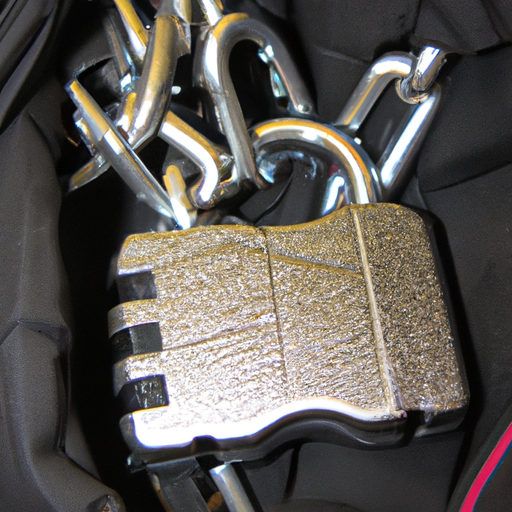How To Lock A Backpack
Are you tired of constantly worrying about the safety of your belongings while traveling? Look no further! In this article, you will learn the simple yet effective technique of how to lock a backpack. By following these easy steps, you can enjoy peace of mind knowing that your valuables are secure, whether you’re trekking through the great outdoors or exploring bustling city streets. Don’t let the fear of theft dampen your travel experience – read on to discover the ultimate solution to safeguarding your backpack and its contents.
Choosing a Lock
When it comes to choosing the right lock for your backpack, there are several factors to consider. The first and most important factor is the security level of the lock. You want to ensure that your belongings are safe and protected, so opt for a lock with a high-security level. Look for locks that are specifically designed for backpacks and offer features such as strong materials and advanced locking mechanisms.
Another factor to consider when choosing a lock is the type of lock itself. There are various types available, each with its own advantages and disadvantages. Some common types include zipper locks, cable locks, and combination locks. Zipper locks are attached directly to the zippers of your backpack, preventing them from being opened. Cable locks, on the other hand, secure your backpack by looping a cable through the zippers or other parts of the bag. Combination locks require a unique code to open, providing an additional layer of security.
Lastly, it’s important to check if the lock you choose is approved by the Transportation Security Administration (TSA). If you plan on traveling by air, TSA-approved locks are essential. These locks can be opened by TSA agents if they need to inspect your bag, reducing the chances of the lock being damaged or cut open. Look for locks that have the TSA-approved logo on them to ensure hassle-free traveling.
Preparation
Before you start locking your backpack, it’s essential to prepare it properly. Begin by emptying and organizing the contents of your backpack. Remove any unnecessary items and ensure that everything is neatly arranged. This will make it easier to lock and unlock your backpack without any hassle.
Next, inspect the zippers of your backpack. Make sure they are functioning properly and not damaged in any way. If you notice any issues, consider getting them repaired or replaced before relying on a lock to secure your backpack. Well-maintained zippers are crucial for the effectiveness of any lock you choose to use.
Locking Techniques
Now that you’ve chosen the right lock and prepared your backpack, it’s time to explore different locking techniques. Depending on the type of lock you have, there are several ways to secure your backpack and provide an extra layer of protection.
Zipper locks are quite straightforward to use. Attach the lock to the zippers of your backpack and make sure it is tightly secured. This will prevent anyone from easily opening the zippers and accessing the contents of your bag.
Cable locks offer more flexibility in terms of securing your backpack. Thread the cable through the zippers or other parts of the bag and tighten it. You can also loop the cable around a fixed object, such as a chair or pole, to prevent theft.
Combination locks require you to set a unique code to open them. Choose a combination that you can easily remember but is not predictable. Make sure to mix up the numbers and avoid using easily guessable combinations like your birthdate or simple patterns.
Backpack Accessories
To further enhance the security of your backpack, consider investing in accessories designed specifically to prevent unauthorized access.
Lockable compartments and pockets are a great addition to any backpack. They allow you to store valuable items separately and ensure that they are not easily accessible. These compartments usually come with built-in locks or have attachment points for additional locks.
Lockable zipper pulls are another useful accessory. Replace the regular zipper pulls on your backpack with lockable ones. These zipper pulls have a built-in lock mechanism that prevents them from being opened without the correct key or combination.
Securing straps or cables can be used to add an extra layer of protection to your backpack. These straps can be wrapped around your backpack or secured to a fixed object, making it difficult for someone to snatch or open your bag without your knowledge.
Travel Tips
While using locks to secure your backpack is essential, there are additional tips you should keep in mind to ensure the safety of your belongings while traveling.
Never leave your backpack unattended, especially in public places. Always keep an eye on your bag and make sure it is within your sight. Opportunistic thieves may take advantage of a momentary lapse in attention and quickly snatch your bag.
Don’t forget the combination or key to your lock. This may seem obvious, but it’s easy to get caught up in the excitement of traveling and forget important details. Before you embark on your journey, memorize your combination or keep your key in a safe and easily accessible place.
When going through airport security, notify the officials about the lock on your backpack. This will prevent any complications or delays during the screening process. TSA agents are trained to handle backpack locks, and by informing them, you can ensure a smooth and hassle-free experience.
Alternative Security Measures
In addition to using locks, there are other security measures you can consider to protect your backpack and its contents.
Slash-resistant materials are designed to prevent thieves from cutting through the fabric of your backpack. Look for backpacks made from materials such as slash-proof nylon or Kevlar. These materials make it much more difficult for someone to slash your backpack open and access your belongings.
RFID-blocking technology is becoming increasingly important in the digital age. This technology protects your personal information stored in cards with radio frequency identification (RFID) chips from being remotely scanned or stolen. Some backpacks offer built-in RFID-blocking pockets to keep your cards safe from unauthorized scanning.
Maintenance and Care
To ensure that your locks are always in good working condition, regular maintenance and care are crucial.
Regularly clean your locks using a soft cloth and mild soap. This will help remove any dirt or debris that may hinder the operation of the lock. Avoid using harsh chemicals or abrasive materials that could damage the lock’s surface.
Inspect your locks for any signs of wear and tear. Over time, locks may become worn-out or lose their effectiveness. If you notice any issues such as rust, stiffness, or difficulty in unlocking, it may be time to replace the lock to maintain the security of your backpack.
Safety Reminders
While securing your backpack is important, it’s also essential to consider safety aspects related to carrying a backpack.
Be mindful of the weight of your backpack. Carrying a heavy load can strain your body and cause discomfort or injury. Distribute the weight evenly and avoid overpacking. Consider using a backpack with padded shoulder straps and a supportive back panel to ensure comfort and prevent back pain.
Don’t overstuff your backpack. Stuffing your bag to its maximum capacity not only puts strain on the seams and zippers but also increases the risk of items falling out or getting damaged. Leave some room for flexibility and ease of access to your belongings.
Legal Considerations
Before using locks on your backpack, it’s important to check local laws and regulations regarding their use. Some countries or regions may have specific rules regarding the use of locks on backpacks, especially in public spaces or when traveling. Familiarize yourself with these regulations to ensure that you are in compliance and avoid any legal issues.
Avoid locking valuable items in checked luggage. While locks can provide an extra layer of security, they are not foolproof. If you have valuable belongings such as electronics or jewelry, it’s best to keep them with you in your carry-on bag. This way, you can keep a close eye on them and reduce the risk of loss or theft.
Conclusion
Locking your backpack is an essential step to protect your belongings while traveling. By choosing the right lock and following the recommended locking techniques, you can greatly enhance the security of your bag. Remember to consider additional accessories, such as lockable compartments and lockable zipper pulls, to further safeguard your belongings. Follow important travel tips and alternative security measures for added peace of mind. Regular maintenance and care of your locks will ensure their longevity, and it’s important to stay mindful of weight and packing considerations. Lastly, be aware of local laws and regulations to ensure compliance and avoid any legal complications. With these tips in mind, you can confidently lock your backpack and embark on your travels with peace of mind.




